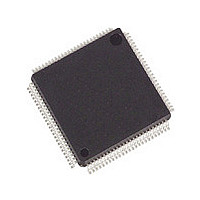AD8114AST Analog Devices Inc, AD8114AST Datasheet - Page 20

AD8114AST
Manufacturer Part Number
AD8114AST
Description
IC VIDEO CROSSPOINT SWIT 100LQFP
Manufacturer
Analog Devices Inc
Datasheet
1.AD8114ASTZ.pdf
(32 pages)
Specifications of AD8114AST
Rohs Status
RoHS non-compliant
Function
Video Crosspoint Switch
Circuit
1 x 16:16
Voltage Supply Source
Dual Supply
Voltage - Supply, Single/dual (±)
±4.5 V ~ 5.5 V
Operating Temperature
-40°C ~ 85°C
Mounting Type
Surface Mount
Package / Case
100-LQFP
Array Configuration
16x16
Number Of Arrays
1
Screening Level
Industrial
Pin Count
100
Package Type
LQFP
Power Supply Requirement
Dual
Lead Free Status / RoHS Status
Not Compliant
Available stocks
Company
Part Number
Manufacturer
Quantity
Price
Company:
Part Number:
AD8114AST
Manufacturer:
WSI
Quantity:
141
Company:
Part Number:
AD8114ASTZ
Manufacturer:
AMI
Quantity:
24
Company:
Part Number:
AD8114ASTZ
Manufacturer:
Analog Devices Inc
Quantity:
10 000
Part Number:
AD8114ASTZ
Manufacturer:
ADI/亚德诺
Quantity:
20 000
AD8114/AD8115
of 2 that eliminates the need for a gain-of-2 buffer to drive a
video line. Its high output disabled impedance minimizes signal
degradation when paralleling additional outputs.
CREATING LARGER CROSSPOINT ARRAYS
The AD8114/AD8115 are high density building blocks for
creating crosspoint arrays of dimensions larger than 16 × 16.
Various features, such as output disable, chip enable, and gain-
of-1 and gain-of-2 options, are useful for creating larger arrays.
When required for customizing a crosspoint array size, they can
be used with the AD8108 and AD8109, a pair of (unity gain and
gain-of-2) 8 × 8 video crosspoint switches, or with the AD8110
and AD8111, a pair of (unity gain and gain-of-2) 16 × 8 video
crosspoint switches.
The first consideration in constructing a larger crosspoint is to
determine the minimum number of devices required. The 16 ×
16 architecture of the AD8114/AD8115 contains 256 points,
which is a factor of 64 greater than a 4 × 1 crosspoint (or
multiplexer). The PC board area, power consumption, and
design effort savings are readily apparent when compared to
using these smaller devices.
For a nonblocking crosspoint, the number of points required is
the product of the number of inputs multiplied by the number
of outputs. Nonblocking requires that the programming of a
given input to one or more outputs does not restrict the
availability of that input to be a source for any other outputs.
Some nonblocking crosspoint architectures will require more
than this minimum as calculated above. Also, there are blocking
Rev. B | Page 20 of 32
architectures that can be constructed with fewer devices than
this minimum. These systems have connectivity available on a
statistical basis that is determined when designing the overall
system.
The basic concept in constructing larger crosspoint arrays is to
connect inputs in parallel in a horizontal direction and to wire-
OR the outputs together in the vertical direction. The meaning
of horizontal and vertical can best be understood by looking at
a diagram. Figure 48 illustrates this concept for a 32 × 32
crosspoint array that uses four AD8114s or AD8115s.
The inputs are each uniquely assigned to each of the 32 inputs
of the two devices and terminated appropriately. The outputs
are wired-OR’ e d together in pairs. The output from only one of
a wire-OR’ e d pair should be enabled at any given time. The
device programming software must be properly written to cause
this to happen.
IN 00–15
IN 16–31
Figure 48. 32 × 32 Crosspoint Array Using AD8114 or Four AD8115s
R
R
TERM
TERM
16
16
16
16
AD8114
AD8115
AD8114
AD8115
OR
OR
16
16
16
16
AD8114
AD8115
AD8114
AD8115
OR
OR
16
16













